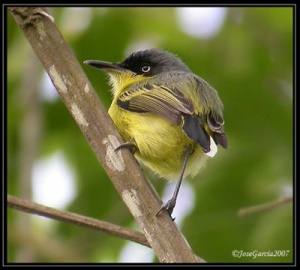| This article is incomplete. This article is missing one or more sections. You can help the BirdForum Opus by expanding it. |

Southern end of the Pipeline Road looking northwest in Parque Nacional Soberania, Colón Province, Panama, northwest of Gamboa, east of the Panama Canal, February 2011
Overview
Pipeline Road at the end of Gamboa town (canal area) offers great birding opportunities: it goes 17 km north at the east bank of the Panama Canal. Located at the Soberania National Park, only 40 minutes drive from Panama City the diversity of Pipeline Road can be attributed to the habitat heterogenity in the park: primary and secondary forest, swamps, streams and uplands.
With 105 mammal species, 525 bird species, 79 species of reptiles, 55 amphibians and 36 species of freshwater fish, the park is an important wildlife refuge. 1
Birds
Notable Species
Several professional ant-followers can be seen: Spotted Antbird, Bicolored Antbird, Ocellated Antbird, Chestnut-backed Antbird and the prized Rufous-vented Ground Cuckoo, if you are very lucky! Manakins include Golden-collared, Velvety and Red-capped Manakin. Pipeline is well known for its trogons, five of which can be seen in a very lucky day: Slaty-tailed, Violaceous and Black-throated being the more common. The long never-ending whistle of the Great Jacamar reveals the presence of this spectacular bird too.
On fig trees it is easy to see fruit eaters like Purple-throated Fruitcrow, Scarlet-rumped Cacique, and several species of toucans. Red-Lored Amazons are always present, and in the wetter areas Brown-hooded Parrot.
Cinnamon Woodpeckers are common in the first part of the road as well as Black-cheeked Woodpecker, Crimson-crested Woodpecker and Lineated Woodpecker. This road is particularly good for woodcreepers; the most common is the Cocoa Woodcreeper.
At Pipeline there is always the possibility of finding rare raptors like Collared Forest Falcon, Semiplumbeous Hawk, or Black Hawk-Eagle.
Check-list
Birds you can see here include:
To do
Other Wildlife
To do
Site Information
History and Use
During World War II a pipeline was built to transfer fuel from one ocean to the other, and today the road built for this purpose is one of the best birding locations in Central America.
Areas of Interest
The wetland areas before Pipeline should be scanned for Rufescent Tiger Heron, elusive White-throated Crake, Wattled Jacana, Snail Kite and maybe a Limpkin.
Besides the Oleoducto trail, which is particularly recommended for ornithologists, there are three other nature trails: the Charco Trail, Plantaciones trail and Creces trail.2
Access and Facilities
Administrative headquarters, a visitor center and basic services can be found in Gamboa. In Aguas Claras, there is a control post and a ranger station with basic services. There is a camping site in the protected area. 1
Contact Details
507 229-7885 (National Park Office)1




